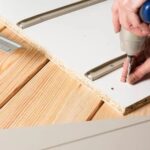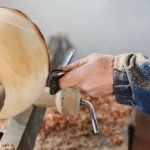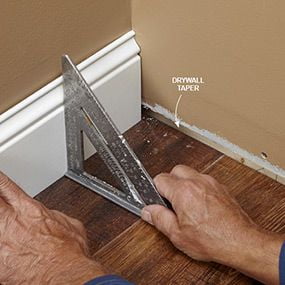What respirator for woodworking? Woodworking is a rewarding and creative activity, but it often involves exposure to potentially harmful substances such as sawdust, wood particles, and chemicals. In this article, we will explore the importance of wearing a respirator while woodworking and discuss the different types of respirators available for woodworkers. Whether you are a beginner or an experienced woodworking enthusiast, understanding the significance of proper respiratory protection is crucial for your health and well-being.
Woodworking Respirators come in various types, each designed to provide different levels of protection against airborne hazards. Respirators with NIOSH ratings are particularly important as they indicate the level of filtration efficiency and protection offered by the device. We will delve into the significance of NIOSH ratings and how they can help you choose the right respirator for your woodworking needs.
In addition to discussing the different types of woodworking respirators and NIOSH ratings, we will also explore key features to look for in a respirator. Comfort, fit, and filtration efficiency are essential factors to consider when selecting a respirator that not only offers adequate protection but also ensures comfort during long hours of woodworking. Lastly, we will review some of the best-rated respirators for woodworking tasks and provide tips for proper maintenance to prolong their effectiveness.
Types of Woodworking Respirators
When it comes to woodworking, wearing the right respirator is crucial for protecting your health. There are various types of respiratory protection available, each offering different levels of filtration and comfort. Here are some common types of respirators for woodworking:
- Disposable Dust Masks: These are inexpensive and lightweight options that provide basic protection against wood dust and particles. However, they may not offer the same level of filtration as other types of respirators.
- Half-Face Respirators: These cover the nose and mouth and have replaceable filters that capture finer particles. They offer better protection than disposable masks and are more cost-effective in the long run.
- Full-Face Respirators: These provide complete coverage for the face and often come with reusable cartridges for filtering out dust, fumes, and other contaminants. They offer the highest level of protection but may be bulkier and less comfortable for prolonged use.
When choosing a respirator for woodworking, it’s essential to consider the level of filtration needed based on the type of woodworking tasks you’ll be performing.
It’s also crucial to ensure that the respirator fits properly and is comfortable to wear for extended periods. Additionally, factor in any additional features you may need, such as adjustable straps or built-in ventilation systems. Ultimately, selecting the right respirator for woodworking will depend on your specific needs and preferences.
NIOSH Ratings and Standards
When it comes to woodworking, it is crucial to prioritize safety, and wearing a respirator is essential for protecting the lungs from harmful wood dust and other airborne particles. However, choosing the right respirator can be overwhelming due to the variety of options available on the market. Understanding the importance of NIOSH ratings and standards is key to selecting the most suitable respirator for woodworking.
Importance of NIOSH Ratings
The National Institute for Occupational Safety and Health (NIOSH) sets the standard for respiratory protection in the United States. NIOSH ratings indicate the level of protection a respirator provides against airborne contaminants. For woodworking, it is important to choose a respirator with a NIOSH rating of N95 or higher, as these are designed to filter out fine particles, such as wood dust, effectively.
Choosing the Right Respirator
When selecting a respirator for woodworking, it’s essential to consider factors such as fit, comfort, and filtration efficiency. A proper seal is crucial for effective protection, so ensure that the respirator fits securely over your nose and mouth without any gaps. Additionally, adjustable straps and nose pieces can contribute to a comfortable fit during long hours of woodworking. Filtration efficiency is also important, so look for respirators with multiple layers of filter material to capture even the smallest particles.
Respirator Options for Woodworking
There are several types of respirators suitable for woodworking, including disposable masks, half-face respirators with replaceable filters, and powered air-purifying respirators (PAPRs). Each type has its own advantages and limitations, so it’s important to assess your specific woodworking needs and preferences when choosing a respirator.
Disposable masks are convenient for occasional use or short-term projects, while reusable half-face respirators may be more suitable for frequent woodworking tasks. PAPRs offer higher levels of protection and comfort but come at a higher cost.
By understanding NIOSH ratings and considering essential features when choosing a respirator for woodworking, woodworkers can ensure their respiratory health is well-protected while pursuing their craft. Selecting an appropriate respirator based on these factors will contribute to a safe and healthy woodworking environment.
Key Features to Look For
When selecting the right respirator for woodworking, it is crucial to consider several key features to ensure optimal protection and comfort. The first essential feature to look for is a comfortable fit. A well-fitting respirator will create a seal against your face, preventing any harmful particles from entering through gaps. It is important to try on different sizes and models to find the best fit for your face shape.
In addition to fit, filtration efficiency is another critical factor to consider when choosing a respirator for woodworking. Look for respirators that are labeled with NIOSH-approved filters, which are designed to capture a high percentage of airborne particles. Different respirators are rated for different levels of filtration, so be sure to select one that offers adequate protection for the type of woodworking tasks you will be performing.
Another important feature to look for in a woodworking respirator is comfort. Since woodworking projects can often take several hours to complete, it’s essential to choose a respirator that you can wear comfortably for extended periods. Adjustable straps, padded nose pieces, and lightweight materials can all contribute to the overall comfort of the respirator.
| Feature | Description |
|---|---|
| Comfortable Fit | A respirator that creates a seal against the face to prevent gaps |
| Filtration Efficiency | NIOSH-approved filters that capture a high percentage of airborne particles |
| Comfort | Adjustable straps, padded nose pieces, and lightweight materials for extended wear |
Selecting a woodworking respirator with these key features in mind will help ensure proper protection while working with wood. Remember that regular maintenance and filter replacements are also essential for maintaining optimal performance from your chosen respirator.
Best Respirators for Woodworking
When it comes to woodworking, protecting your respiratory system is crucial. With the variety of wood dust and particles that can be released during woodworking tasks, wearing a respirator is essential. But with so many options available, it can be overwhelming to choose the right one for your needs. This section will review some of the best respirators for woodworking and discuss their suitability for different woodworking tasks.
One popular option for woodworking respirators is the N95 disposable respirator. These are affordable and provide basic protection against wood dust and particles. They are suitable for light to moderate woodworking tasks such as sanding, sawing, or drilling.
Another option to consider is a half-face respirator with P100 filters. These provide higher filtration efficiency compared to N95 respirators and offer better protection against finer wood particles and harmful fumes. They are ideal for more intensive woodworking projects such as working with hardwoods or using chemical finishes.
For those who need even more advanced protection, a powered air-purifying respirator (PAPR) may be the best choice. These units use a battery-powered fan to draw in air through a filter, providing both respiratory and eye protection. PAPRs are suitable for professional woodworkers, especially those working in commercial settings where heavy machinery is used and there is increased exposure to wood dust and chemicals.
In order to make an informed decision on what respirator for woodworking is best suited for your needs, it’s important to consider factors such as comfort, fit, and filtration efficiency. Each type of respirator has its own advantages and limitations, so understanding these factors will help you select the best option for your specific woodworking tasks.
| Respirator Type | Suitable Woodworking Tasks |
|---|---|
| N95 Disposable Respirator | Light to moderate tasks such as sanding, sawing, or drilling |
| Half-Face Respirator with P100 Filters | More intensive projects including working with hardwoods or using chemical finishes |
| Powered Air-Purifying Respirator (PAPR) | Professional woodworkers working in commercial settings with heavy machinery and increased exposure to wood dust and chemicals |
Proper Respirator Maintenance
Proper maintenance of a respirator is crucial for ensuring optimal performance and protection while woodworking. Neglecting to clean, store, and replace filters can compromise the effectiveness of the respirator, exposing woodworkers to harmful airborne particles. This section will provide valuable tips for maintaining respirators to extend their lifespan and maximize their protective capabilities.
Cleaning Your Respirator
After each use, it is essential to clean your respirator to remove any accumulated dust, debris, or contaminants. Begin by disassembling the respirator according to the manufacturer’s instructions. Wash the components with mild soap and warm water, ensuring thorough cleaning of all surfaces, straps, and filters. Allow the respirator to air dry completely before reassembling it for future use.
Storing Your Respirator
Proper storage is critical in maintaining the integrity of your respirator. Store it in a clean, dry environment away from direct sunlight, extreme temperatures, or chemicals that could degrade the materials. Additionally, ensure that the respirator is stored in a sealed container or bag to prevent dust and contaminants from settling on its surfaces between uses.
Replacing Filters
Regularly inspect the filters for signs of damage, clogging, or wear. Follow the manufacturer’s guidelines for filter replacement intervals based on usage and environmental conditions. When replacing filters, be sure to use approved replacements that are compatible with your specific respirator model to maintain its level of protection.
By following these maintenance tips for cleaning, storing, and replacing filters for your woodworking respirator, you can ensure consistently optimal performance and safeguard your respiratory health while working with wood.
Remember that proper care and maintenance contribute significantly to the effectiveness of your chosen respirator
Safety Precautions
Woodworking involves the creation and manipulation of wood, which can produce a significant amount of dust and fumes. In addition to wearing a respirator, it is important to implement other safety measures to minimize health risks associated with woodworking. Proper ventilation and dust collection systems play a crucial role in maintaining a safe and healthy working environment.
When working with wood, it is essential to have adequate ventilation in the workspace. This can be achieved through the use of exhaust fans, air filters, and open windows or doors to allow for air circulation. Good ventilation helps in reducing airborne particles and pollutants, promoting better air quality for the woodworker.
In addition to ventilation, implementing effective dust collection systems is vital for removing wood dust from the air and surfaces. Wood dust can pose serious health hazards when inhaled, leading to respiratory issues such as asthma and lung diseases. To mitigate these risks, woodworkers should invest in high-quality dust collectors, shop vacuums, or dust extraction systems that are specifically designed for woodworking environments.
It is important for woodworkers to regularly maintain their ventilation and dust collection systems to ensure optimal functionality. Cleaning filters, emptying collection bags, and inspecting equipment for any malfunctions are crucial tasks that should be performed on a routine basis. By combining proper ventilation with effective dust collection systems, woodworkers can create a safer work environment while minimizing exposure to harmful airborne particles.
Conclusion
In conclusion, selecting the right respirator for woodworking is crucial for protecting your respiratory health. With various options available, woodworkers should prioritize comfort, fit, and filtration efficiency when choosing a respirator. NIOSH ratings play a significant role in determining the level of protection provided by different respirators, making it essential to understand and consider these ratings when making a purchase. Additionally, proper maintenance, including regular cleaning and filter replacement, is necessary to ensure optimal respirator performance.
It’s important to remember that wearing a respirator is just one aspect of staying safe while woodworking. Adequate ventilation and dust collection systems are also crucial for minimizing exposure to wood dust and other harmful particles. By taking these additional safety measures into account, woodworkers can create a safer working environment for themselves and those around them.
In essence, investing in the right respirator and prioritizing safety precautions while woodworking not only protects against immediate health risks but also contributes to long-term respiratory well-being. With the knowledge of NIOSH ratings, key features to look for in a respirator, proper maintenance practices, and additional safety measures in mind, woodworkers can continue pursuing their craft with confidence and peace of mind.
Frequently Asked Questions
Should You Wear a Respirator When Woodworking?
It is highly recommended to wear a respirator when woodworking, especially when handling materials that produce fine dust particles. Wood dust can be harmful to the respiratory system, so wearing a respirator helps protect your lungs.
What Kind of Mask Should I Wear for Woodworking?
When choosing a mask for woodworking, it’s important to select one that is specifically designed for filtering out fine dust particles. Look for masks labeled as “N95” or “P100,” which are effective in preventing inhalation of wood dust and other airborne particles.
Is N95 Enough for Woodworking?
While N95 masks are effective in filtering out most wood dust and particles, some experts recommend using a higher level of protection such as P100 masks for more efficient filtration. The decision ultimately depends on the individual’s sensitivity to wood dust and level of exposure during woodworking activities.

Hi everyone! I’m a woodworker and blogger, and this is my woodworking blog. In my blog, I share tips and tricks for woodworkers of all skill levels, as well as project ideas that you can try yourself.





